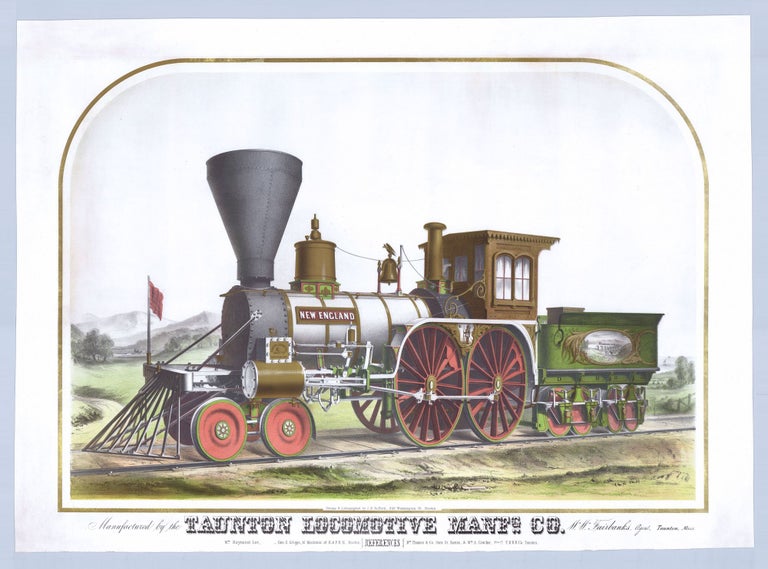Manufactured by the Taunton Locomotive Manfg. Co. W. W. Fairbanks, Agent. Taunton, Mass.
Boston, [1851-1855]. Drawn & lithographed by J. H. Bufford, 260 Washington St. Chromolithograph, 19” x 27.5” plus printed border and margins. A handsome chromolithograph issued by the Taunton Locomotive Manufacturing Company of Taunton, Mass. in the heyday of locomotive builders’ advertising prints. The engine featured here, the New England, is shown with its tender on railroad tracks in what appears to be an imaginary landscape combining a valley in the White Mountains with a coastal view (effectively a composite of two salient characteristics of New England). As in most locomotive advertising prints, the engine is shown in great detail, emphasizing both its mechanical ingenuity as well as a number of decorative features. Among the latter are an eagle surmounting the bell, the Massachusetts state seal (a painted full-length portrait of a Native American man with bow and arrows), and, on the side of the tender, a landscape painting depicting a train crossing a bridge, with mountains in the background. Established in 1849, Taunton Locomotive was one of the first locomotive building companies in the United States. It was founded by William A. Crocker, Willard W. Fairbanks, Willliam R. Lee, and others. The company built some 675 engines between 1849 and 1877, then began to lose ground to competitors building more technologically advanced engines. John Henry Bufford (1810–1870) was born in Portsmouth, New Hampshire and in 1829 began apprenticing as a lithographer with the Pendleton firm in Boston, during the period when American lithography was just starting to become a technique used in commercial printing. Remaining with Pendleton until 1835, Bufford then left to start his own firm in New York. Here he printed book illustrations, sheet music covers, city views, and copies of popular artworks. Bufford also produced prints depicting disastrous fires, and worked as an artist for the Endicott and Currier firms in New York. Upon returning to Boston in 1840, he and his brother-in-law B. W. Thayer and John E. Moody bought out Pendleton, owned by Thomas Moore since 1836. Bufford worked as the primary artist and general manager of the new company, B. W. Thayer & Co., which was one of the first color lithographers in the U.S.—producing work from several stones as early as 1843 or 1844. When Thayer left the company in 1845, the firm became J. H. Bufford & Co. Bufford was one of the most important lithographers in antebellum America—his work encompassing city views, posters, book illustrations, sheet music covers, and prints for framing. Early in their careers, both Winslow Homer and Francis D’Avignon worked for Bufford. In 1865, Bufford's sons Frank and John Henry Jr. became partners in his company. Following their father’s death in 1870, the brothers continued operating the firm until the early 1900s. “With the introduction of chromolithography in the 1840s and ‘50s, locomotive manufacturers began commissioning color prints of their engines. Early American locomotives were often painted and colorfully decorated; chromolithographic locomotive builders’ prints offer a rare insight into the decorative designs, finishes, and materials favored by manufacturers. The use of color in the 1850s ushered in what has been called the golden age of the locomotive builders’ prints. Larger in scale than the prints of the 1830s and early 1840s, they were composed of bold, opaque colors with glittering bronze and metallic powders. As locomotive manufacturers competed for the customer’s eye, lithographic artists began portraying locomotives in landscapes often with reference to the factories in which they were built…These lavish prints were much prized by locomotive manufacturers. The daguerreotype, Hyram White, Engineer, Taunton Locomotive Works, depicts White holding a locomotive builders’ print, and reflects the designer’s pride in both the engine and its elegant lithographic portrait” (Catharina Slautterback, Locomotive Builders’ Prints). REFERENCES: Pierce, Sally and Catharina Slautterback. Boston Lithography, 1825-1880 (Boston, 1991), p. 130-31; Last, Jay T. The Color Explosion (Santa Ana, California: Hillcrest Press, 2005), pp. 47-48; Slautterback, Catharina. Locomotive Builders’ Prints at cdm.bostonathenaeum.org. CONDITION: Good, margins expertly extended, mild toning and staining, no tears.
Item #5364
Sold


